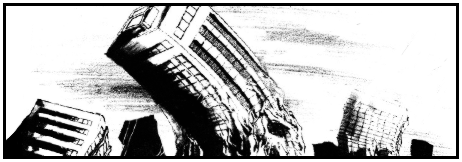
Abnormal Structures
The Baroque Report series confirms that two books (“Time and Self” and “Abnormal Structures”) by Bin Kimura, a Japanese psychiatrist specializing in schizophrenia, were large influences in Baroque’s development. Kimura’s philosophy is featured prominently in the game, from overarching themes such as the subjective nature of reality to minor details and homages such as Thummim echoing Kimura’s sentiments about not condemning people for their distortions. Like most countries in the world, Japan has had a long history of prejudice and oppression against the mentally ill, and Kimura’s views that the mentally ill deserve to be a part of society were progressive for their time (and unfortunately, even today). These traditional prejudices have already been discussed in my "Baroque Shinto" analysis article.
Many of Kimura’s theories hinge on the subjective nature of reality. The argument goes that the colors you see in nature do not actually exist. Color is merely a fabrication created by the cones of our eyes. Furthermore, the images we see are constructs - approximations based on data gathered by our sensory organs. Following this logic, our entire “reality” is based solely on these assumptions. It is an “illusion”.
Bin Kimura goes further, proposing that just as an eye cannot truly perceive reality, an eye cannot directly observe itself. Therefore, we cannot directly observe or fully understand our true selves. Instead, we define ourselves by observing the world around us and attempting to differentiate ourselves from it. As a species, we’ve formed a consensus on what constitutes “reality”, but this “reality” is ultimately a fiction - a fiction Kimura claims is favored by the majority of humanity because it delusionally separates humans from the rest of nature. However, schizophrenics and other people with mental illnesses are unable to form the same conclusions concerning themselves or the reality we inhabit. Kimura argues that neurotypical people feel the need to reject and ostracize these afflicted individuals because their abnormal and often uncanny assumptions about the world are in direct conflict with the world everyone else believes to be real. However, the world everyone else believes to be real is, in many ways, just as illusory as the world of the schizophrenic. Through this reasoning, Kimura argues that “sane” and “insane” are not necessarily opposites and that the mentally ill have just as much right to be a part of society as neurotypicals do.
There’s a good chance that these themes concerning the subjective nature of reality and acceptance for people suffering from “abnormalities” (whether they be physical or mental) already sound familiar to anyone who has played through Baroque. This subjective view of reality influenced not just the game’s dialogue, but also the construction of the game’s plot itself. In the December 2021 issue of “Eureka”, Yonemitsu summarizes the book explaining his creative process (“Tarot as a Thinking Tool”) and how he discovered this technique while writing Baroque. An established method for defeating writer’s block is to temporarily abandon an idea. Events experienced during one's time away from their project have a tendency to suddenly cause writers to see their work in a new light and discover an alternate way of moving forward. However, Yonemitsu explains that one does not always have the luxury of time when working against deadlines. It was a desire to automate and expedite this process that led him to use the Tarot in order to inject new ideas and perspectives into his writing.
The Tarot had already entered Baroque’s development cycle when the production managers criticized Yonemitsu’s insistence on quality over quantity in regards to the game’s elaborate monsters. Such detailed models made it impossible to afford more than twenty or so enemies. The marketing division feared this would negatively impact sales, so Yonemitsu had to scramble to find an excuse that would allow him to proceed. To convince them, he made up the argument that such a small number of enemies was relevant to the plot because the Archangel modeled the creatures after the 22 cards of the Major Arcana. Thanks to this clever excuse, Yonemitsu was already in possession of a Tarot deck (in order to study the symbolism he would now be using to design each Grotesque). He eventually discovered that during bouts of writer’s block, he could draw one of the Major Arcana cards at random and instantly be presented with a new perspective to re-examine his ideas through. He no longer had to wait for a new perspective to come to him; now he could instantly generate new and unexpected methods for moving forward.
He soon turned over most of the creative process to the Tarot and generated a large number of disconnected concepts. For instance, Eliza’s “Please give me your pure water” line was drawn from the water imagery and themes of establishing balance found within the Temperance card. He didn’t understand what any of these concepts meant or how they tied together, but as he generated more and more of them, his mind gradually began to create links between these fragments. Just as Bin Kimura claims we construct our own personal reality from random sensory data, Yonemitsu began to construct the world of Baroque through these Tarot-generated concepts. This once disconnected mosaic began to come together into a clear progression of logic and events.
Baroque is a game that doesn’t just discuss the subjective nature of reality, it is a game that was explicitly created through it. I fully believe that the experience Yonemitsu had writing the game is exactly the experience he intends the player to have while playing it. Snippets of the story are presented to the player in a highly disorganized fashion. These fragments are not only missable - they sometimes don’t even fit together due to the characters' own subjective views of reality. It’s left up to the player to construct their own personal story as they traverse this bizarre and alien reflection of our reality. As Yonemitsu explains, “To me, Tarot cards are not a tool to create by way of magic, but rather a process that results in magic.”
Additional Notes
-
Bin Kimura is well known for his “Festum” model of describing psychological disorders. He claims manic depressives are in a state of “post-festum” or “after the festival”, in which they pine after their personal prime. Conversely, schizophrenics are supposedly “ante-festum” or “before the festival”, as Kimura claims they are constantly in a state of anticipation over discovering their true self. This “festum” terminology (フェストゥム) is written identically to the name of the Festum enemies found in Baroque.
-
Bin Kimura means well, but his books make some problematic claims based on pseudoscience - namely the insistence that children of highly intellectually or ethically-concerned parents (such as educators, lawyers, or clergy) are more likely to be schizophrenic because their developing worldview will clash with the large amount of opinions that their parents actively reject. This is complete nonsense that disregards schizophrenia’s genetic factors while also stating that having unusual views of reality will lead to “emotional indigestion” that can result in mental illness, and ultimately, schizophrenia. This is blatantly false, and unfortunately seems to feed into Japan’s traditional prejudices against schizophrenia.
-
At first I thought Baroque was also making these unfortunate claims (under the pretense that “Baroques” or "distorted delusions" lead to people going mad), but the game only ever presents “Baroques” as coping mechanisms that people develop in order to deal with their own pre-existing abnormalities or trauma. The Archangel appears to be under the mistaken impression that Baroques cause mental illness as well (“the people of this world suffer under the influence of their Baroques”), but he later realizes his mistake in the PS1 version (coming to the conclusion that perhaps Baroques instead offer salvation from suffering).
-
The “Baroquism Syndrome” stories, on the other hand, definitely paint a more traditionally Japanese view of everyday fantasies. Shimizu's work depicts Baroques as being capable of driving people into crazed states that resemble bigoted caricatures of mental illnesses (like bipolor disorder and schizophrenia, which are often falsely depicted as “scary” or “violent” conditions). This could be explained by Yonemitsu’s minimal involvement in these stories, as he was incredibly overburdened with the enormous workload of Baroque at the time. Mariko Shimizu confirms in her "Baroque World Guidance” interview that Yonemitsu had very little input on these stories other than removing game spoilers from her manuscripts.
|










